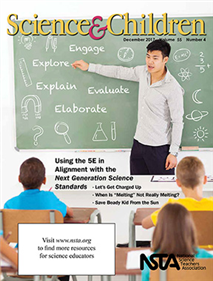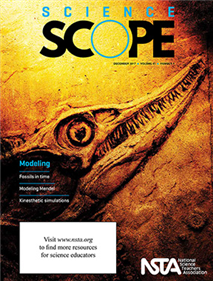All Resources
Journal Article
A method for integrating science and engineering instruction...
Journal Article
Assessment strategies reinvigorate a 6E lesson on batteries, bulbs, and electric circuits....
Journal Article
Kindergarteners investigate forces and use engineering to corral an unpredictable robot....
Journal Article
Art and science help students investigate light energy and practice fair testing....
Journal Article
When Is Melting Not Really Melting?
Building explanations through exploration using an engaging toy...
Journal Article
Editor's Note: Developing Coherent Lessons With the NGSS and 5E
Science and Children’s editor shares thoughts regarding the current issue....
Journal Article
The Early Years: Using the 5Es to Teach Seasonal Changes
Learn how to use a thermometer to investigate and document seasonal changes in the local environment....
Journal Article
The Poetry of Science: Learning About Trees With the 5Es
Building literacy in playful, meaningful ways. Students learn about crossdating tree-ring samples....
Journal Article
Teaching Through Trade Books: Codes and Communication
This column includes activities inspired by children’s literature. In this month’s column, younger students consider ways that they can communicate using simple code systems and then apply their new knowledge to ways we communicate today. Meanwhi...
Journal Article
Formative Assessment Probes: Embedding Formative Assessment Into the 5E Instructional Model
This column focuses on promoting learning through assessment. This month’s issue includes an illustrative example of how formative assessment probes and formative assessment classroom techniques can be embedded into a sequence of 5E lessons target...
Journal Article
Science 101: Why Do You Add Salt When Making Homemade Ice Cream?
This column provides background science information for elementary teachers. This month’s issue discusses the role of salt when making ice cream....
Journal Article
This column shares exercises to challenge content knowledge. This month's issue presents a new challenge and answers the The Face That Follows You challenge from last month....
Journal Article
Teaching Teachers: Assessing Students as Scientists
This column enhances the repertoire of preservice and inservice teachers. Supporting teachers in assessing students’ scientific thinking....
Journal Article
Methods and Strategies: What’s the Story?
This column provides ideas and techniques to enhance your science teaching. This month’s issue discusses using the 5E learning cycle to create coherent storylines....
Journal Article
Engineering Encounters: What’s The Buzz on Bees?
This column presents ideas and techniques to enhance your science teaching. This month's issue shares information about a flower anatomy and honeybee pollination unit that incorporates inquiry and engineering....
Journal Article
Deep Thinking Over Geologic Time: Understanding Fossils and Relative Dating
Explore geologic time with this series of hands-on activities....
Journal Article
Using Imagery Support Strategies to Develop Powerful Imagistic Models
Create scientific models using imagery....
Journal Article
Modeling Mendel: Using a Puzzle-Solving Activity to Develop Ideas About Genetics
Develop Punnett squares that explain observed patterns....
Journal Article
Engaging All Students in Science Practices Through a Cell Modeling Lesson
Construct models of photosynthesis and cellular respiration while providing science language learning opportunities....
Journal Article
Constructing Scientific Models Through Kinulations
Learn to kinesthetically model scientific phenomena....
Journal Article
Classic Lessons 2.0: Explaining Patterns in Our Solar System and the Role of Gravity in Space
This column shares updated perennial classroom favorites. This is the last of three articles written to highlight pedagogical approaches consistent with the Next Generation Science Standards for supporting students’ learning progression of Earth’...
Journal Article
Teacher’s Toolkit: Science Can Be a Piece of Cake!
This column provides how-to strategies and practical advice for the science teacher. Improving science comprehension through analogies....
Journal Article
From the Editor’s Desk: No Glue Required
Science Scope’s editor shares thoughts regarding the current issue....
Journal Article
Citizen Science: Did You Feel It?
This column highlights formal and informal science research projects that students can join and contribute to by gathering and sharing data. Shake up your Earth science classroom with earthquake citizen science....
Journal Article
Disequilibrium: Wildfires, the Fire Triangle, and CO2 Extinguishers
This column shows how to use discrepant events to confront misconceptions. This month’s discrepant event models a CO2 fire extinguisher, helps students understand the fire triangle, and allows students to ponder ways to mitigate the effects of wil...
Journal Article
Listserv Roundup: Technology Tools for Paperless Homework
This column shares recent conversations taken from the NSTA listserv community about current science education topics. This month’s column is all about the technology tools NSTA e-mail listserv members use to assign and manage homework....
Journal Article
Science for All: Using Formative Assessments to Differentiate Instruction
This column shares strategies for increasing student engagement. This month's issue discusses how to keep formative assessment methods informative and engaging to maximize student participation and performance....
Journal Article
Teacher To Teacher: Creating Conceptual Storylines
This column provides practical advice from your peers. A conceptual storyline employs a narrative approach to learning in which students are able to build and retain science concepts. To properly construct a conceptual storyline, educators should de...
Journal Article
Scope on the Skies: Star Chart
This column focuses on astronomy throughout the year. This month’s issue describes the H-R (Hertzsprung-Russell) diagram, which is a representation of the relationship between a star’s luminosity and its temperature....




